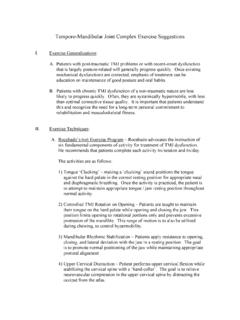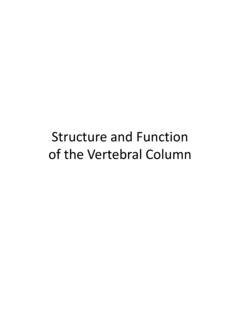Transcription of Version 2.01, May 2018 - suanmokkh-idh.org
1 yoga Routine Version , May 2018 By Khun Reinhard CONTENT page 1. Introduction 2 2. Overview 3 Time frame 3 Postures 4 3. yoga routine 5 Standing postures 5 Sun salutation 6 Supine postures lying on the back 7 Prone postures lying on the front 9 Sitting postures 11 Final relaxation corpse posture 12 4. About the author 13 yoga Routine Khun Reinhard - 2 - 1. Introduction This yoga routine has been taught by the author of this paper over many years to more than male participants of the meditation retreats at the Suan Mokkh International Dharma Hermitage in Thailand.
2 Women have separate yoga classes, taught by a female instructor, but the routine is similar to this. There are many different postures in yoga and many different schools which teach postures in different ways to achieve different results. Building up strength may require doing the same posture in a slightly different way than if one wants to increase flexibility. It is quite difficult and lengthy to describe in writing the details of postures. Many more details are given orally during practising the exercises. This routine is designed to help participants get through a 10-day meditation retreat which requires hours of sitting each day. The focus is on strengthening the abdominal and back muscles and on opening hips and groins to some extent. This helps participants to sit with straight backs more and more comfort-ably.
3 As neck and shoulder pain is a quite common experience during meditation retreats, some exercises to release tensions in this area are implemented as well. The classes usually have 30 to 60 people. The participants come from all walks of life, aged between 17 and 70 years. Some have not done any exercise for years, others are used to doing some kind of bodily training regularly. The average participant is not very flexible touching the floor with the fingertips when bending forward with straight legs is for many beyond reach when they start the class. Therefore the exercises have to be simple, so that nearly everybody can take part without getting injured or frus-trated. Age and health limitations like back, heart and blood circulation problems, have to be taken into account as well. During the meditation retreat the mind should become calm and peaceful and the participants should be-come aware of what is going on in their body and mind.
4 The yoga class is designed to accomplish just that and so there is no jumping into the postures and there is a lot of relaxation between the exercises and at the end of the class. The routine has evolved over the years to include Very simple loosening exercises that everybody can do for a start, followed by an easy variation of the sun salutation as a warm-up. We then work the abdominal muscles and the muscles of the back and try to bring more flexibility to the back, spine, hips and groin. We end with relaxing body and mind, thus preparing it for meditation. The average participant gains a lot during the 10 days of the yoga class and many continue with the rou-tine or parts of it after the retreat. Three general guidelines should be observed when practising the exercises: Do it slowly Do it with awareness (many postures can be done with eyes closed to increase your awareness) Be stable (do not move) in the final posture The purpose of the following description is to help participants, who have taken part in the yoga class at the International Dharma Hermitage, to remember the routine and some of its details.
5 It cannot serve as a manual for people who have not taken part in our yoga class. yoga Routine Khun Reinhard - 3 - 2. Overview Time frame ----- A) STANDING POSTURES (loosening exercises) 1. Tadasana Mountain posture (Starting position while standing) 2. Neck 3. Shoulders 4. Stretch the sides of the body. 5. Backward bend 30 min. 6. Forward bend 7. Spinal twist 8. Hip rotation 9. Loosening joints and muscles of the legs and balancing exercise B) SUN SALUTATION (warming up) ----- ----- C) POSTURES WHILE LYING ON THE BACK (work abdominal muscles) 1.
6 Learn how to come up from lying on your back to a sitting posture (explained 1st day only, practised every day) 2. Sarwangasana Shoulder stand 15 min. 3. Learn Savasana Corpse posture (explained 1st day only, practised every day) 4. Matsyasana Fish posture 5. Paschimottanasana - Forward bend (sitting) ----- ----- D) POSTURES WHILE LAYING ON THE FRONT (work muscles of the back) 1. Learn relaxation postures while lying on the front (explained on the 2nd day only, practised every day) 2. Diagonal arm and leg lifting 3. Bhudschangasana Cobra posture 4. Salabhasana Locust posture 15 min. 5. Dhanurasana Bow posture 6. Pose of a child (relaxation posture after strong backward-bends) Tiger breathing (Cat & Cow postures) Folded legs spinal twist (lumbar stretch) breathing ----- ----- E) SITTING POSTURES (hip openers) 1.
7 Butterfly 2. Exercise the right/left groin and hip 15 min. 3. Burmese sitting forward bend 4. Butterfly (relaxing) ----- ----- F) FINAL RELAXATION 10 min. ----- ----- Total 85 min. yoga Routine Khun Reinhard - 4 - Postures Standing postures (repeat on opposite side, in reverse direction, with opposite arm or leg, if suitable) Sun salutation - basic - Supine postures Prone postures Kneeling and twisting postures Sitting postures (repeat with right leg)
8 And Final Relaxation 2013 Khun Reinhard H lscher yoga Routine Khun Reinhard - 5 - 3. yoga routine Standing postures (loosening exercises) 1. Tadasana Mountain posture starting position while standing Stand straight, feet together or a little apart, inside of the feet parallel, thighs a little tensed, weight evenly distributed on the feet, shoulders slightly rolled back, ankles, knees, wrists, hips, elbows, shoulders and ears in line. 2. Neck (5B = 5 breaths in and out) Look up to the ceiling and raise the chin high, stretching the throat (5B) Look down to the floor and bring the chin between the collar bones, stretching the neck (5B) Look over the left shoulder (5B), back to centre and look over the right shoulder (5B) Lower the left ear towards the left shoulder and pull right shoulder down (5B), back to centre, lower the right ear towards the right shoulder and pull the left shoulder down (5B), stretching the sides of the neck Rotate the head until the resistance in the neck and reverse the direction (5 times in each direction) 3.
9 Shoulders Alternately lift left and right shoulder (6 times each shoulder) Lift both shoulders at the same time (8 times) Alternately rotate left and right shoulder forward (6 times each) and reverse (6 times each) Rotate both shoulders forward at the same time and then rotate backwards (8 times each) 4. Stretch the sides of the body Raise the right arm sideways up to the vertical, biceps close to the ear, palm of the right hand pointing to the left, the left arm hanging loosely by the side. Bend to the left stretching the right side of the body from the foot to the toe. (To intensify the stretch, look up to the right arm.) (8B) Return to Tadasana and be aware of the sensations in the right side of the body (compare with the left side) (8B) Do the same towards the opposite side 5.
10 Backward bend Place hands on the left and right side of the hip, thumbs and fingertips pointing to the front. Starting from the neck, bend backwards. Stretch of abdomen, chest and throat, with compression of the back (10B) Inhaling straighten up again and focus on the sensation at the front side of the body and in the back (10B) 6. Forward bend (be careful if you have lower back problems) Inhaling, raise both arms to the vertical, palms pointing to the front. Straighten up and bend forward from the lower back. Interlock thumbs and elbows, relax the back and try to bend further down with every exhalation (10B) Bring the arms to the legs and slowly, sliding the arms along the legs stand straight again. Inhaling raise the arms above the head, straighten up and exhaling drop the arms to the side.







